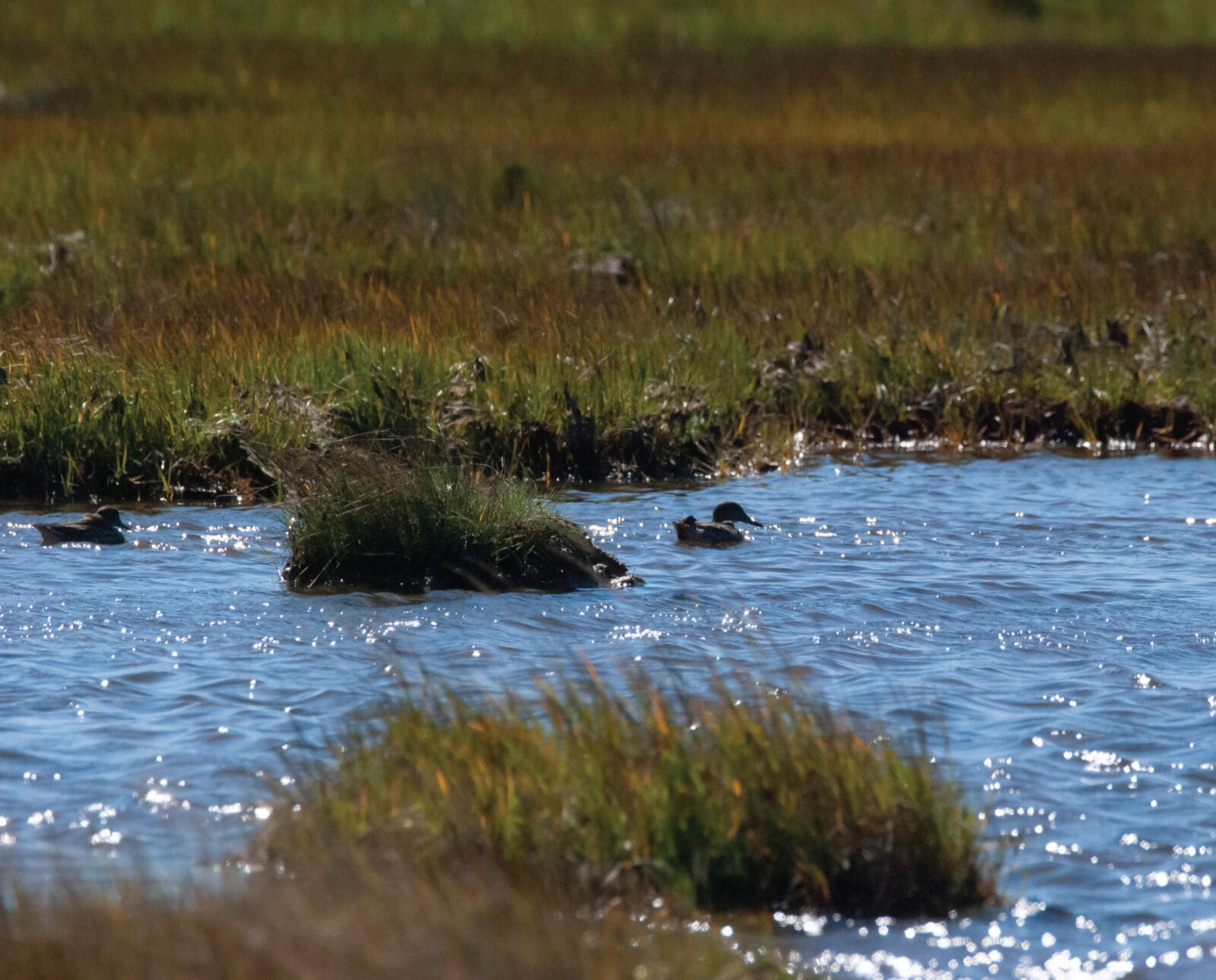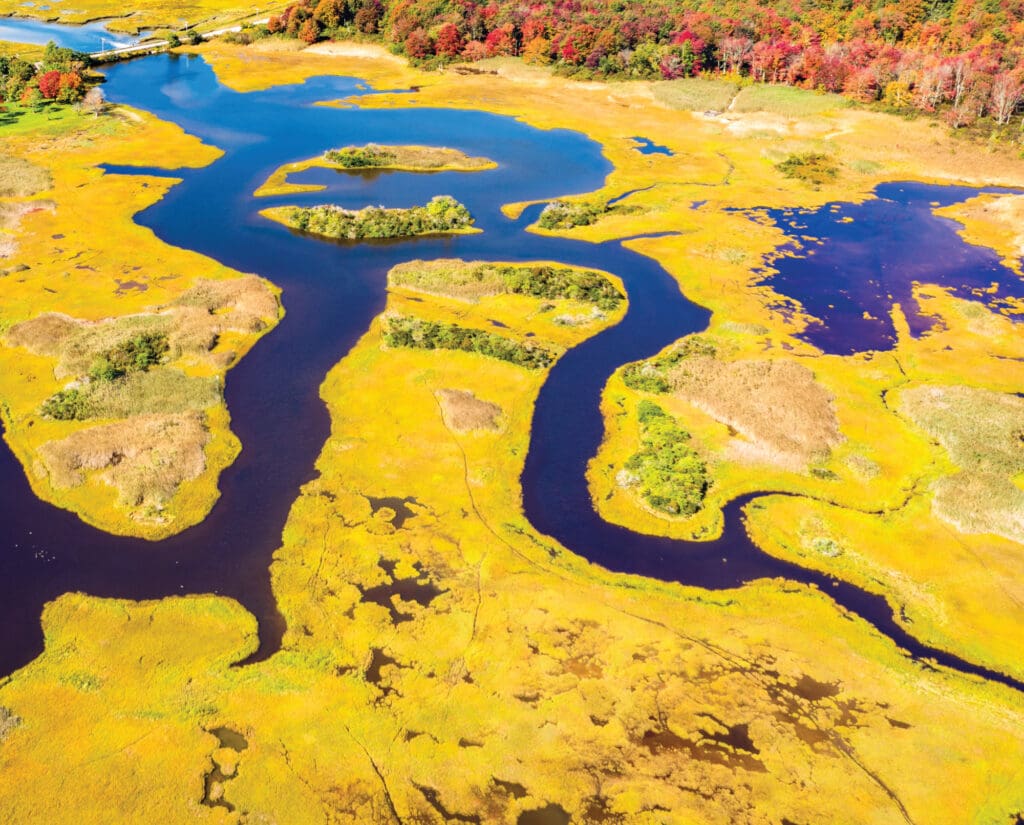Home » Waterfowl Hunting » Hunting Tidal Creeks for Ducks
Hunting Tidal Creeks for Ducks

Mike Adams is an outdoor writer, wildlife biologist, and educator…
Unlock the secrets of tidal creek duck hunting with expert advice on the best times, tactics, and reasons to target these dynamic waterways.
Sometimes, hunting tidal creek marshes becomes more about fighting the terrain than it does shooting ducks. My earliest memory of losing a fight to the marsh came when I was only ten years old. I nearly drowned in a bottomless tidal pool, and if it hadn’t been for my dad plucking by my coat hood, it would’ve been my last hunt ever. Then, there was that time in high school when the current swept away my favorite pair of mallard decoys. They became the first of nearly a dozen lost to the tides. Then, a few years later, I suffered my most humiliating loss.
Listen to more articles on Apple | Google | Spotify | Audible
I will never forget it; I dropped a drake mallard, belly up, on a slick, wide mudflat right along the river bank. Sparing no time to think, I trudged out there to retrieve it and sunk in pluff mud up to my chest. In no time, I was unable to move, and the tide was coming up quick. My buddy had to toss me the bowline of his boat in a desperate rescue attempt. He revved his engine so hard that the water churned into cloudy chocolate milk. I held on for dear life as my legs and boots popped free. As I slid on my belly across the mud like a salt marsh penguin, I promised I’d never make that mistake again.
Like most fights, the best way to avoid a fight with the marsh is to realize you never had to throw a punch in the first place. The best tidal creek hunters already know this. They learned how to hunt with the terrain instead of against it. That saves them time, decoys, and, in the worst moments, even their life. Above all else, these hunters learned that by finessing the tides to their advantage, they could reap some of the best and most rewarding hunts of their lives. Figuring out the game isn’t easy, so here are some tips to help get you started. This is how to hunt tidal creeks for ducks, the right way.
Make a Plan Before You Hunt Ducks in Tidal Creeks
Every tidal creek hunter should have a tide chart tucked in their wader pocket. Printable versions are available, but apps like Tides Near Me do the job just as well. There are a few reasons you don’t want to overlook the tide schedule. First, preparing for the tides allows you to choose where you will hunt. You could have the best duck honey hole in the Lower 48, but if the access creek runs dry at low tide, you will only be able to hunt it on the high tide cycle. Similarly, some spots act as low-use roosting areas during high tide, but when the water level drops, ducks sink closer to benthic forage, turning the area into extremely productive ground.
The tides also dictate your safety. Don’t trudge through pluff mud at low tide, and don’t hunt areas that will leave you stranded when the water level drops. No duck is worth risking your life.
After you account for the tide, it’s time to look at the wind. In most east coast marshes, prevailing winds generally run from the west to the east. That means hunters want to look into the rising sun as they set up on a tidal creek with the wind to their back. The only exception comes when you’re hunting flooded tidal mud flats that are exposed to the wind. Sometimes, these open bodies of water develop white caps that make your decoys bob like surfers in a hurricane. In these conditions, it’s important to hunt the windbreaks provided by thick upwind cover.
The last step in developing your tidal creek playbook is finding backup spots. Estuarine systems change every year. A mild storm can throw up a sandbar where there used to be a ten-foot hole. A deep channel can become a mudflat overnight. Part of the productivity of the marsh, and why ducks love it, is that it’s a dynamic ecosystem with an ever-changing environment. It’s great for the birds but requires extra planning on your part. For that reason, I like to hunt with at least two or three backup spots since, oftentimes, Plan A doesn’t pan out.

Anchor Your Decoys When Hunting Tidal Creeks
Fundamental decoy strategies still apply in a tidal creek setting, but extra security is required. In a still pond, you may get away with using spare fishing sinkers as your decoy weights. In a tidal creek, however, you need to bust out the heavy artillery. Currents run so strong in some tidal creeks that your decoys drift in them like sailboats. If you want that sailboat to stay in place, you need a heavy anchor.
Loop anchors work best in fast current conditions. These anchors grip the mud better than other alternatives and provide enough weight to keep your spreads in place. In some conditions, however, loop anchors are more hassle than what they are worth. For example, one of my favorite tidal marshes to hunt only recently became a marsh. In fact, it is actually an old cedar forest. Over time, saltwater intrusion swallowed the forest whole and upheaved the ecosystem into a salt marsh. The only evidence that remains of the old forest comes in the form of what ecologists call a ghost forest, or a bunch of stumps and root systems that are hundreds of years old lying dead at the bottom of the creeks. Among the almost-fossilized wooden carnage lie dozens of my decoy hoop anchors that got caught up in them.
In marshes with a lot of benthic debris, I’ve learned that heavy lead straps work better. Sometimes, it takes two strung together to hold a decoy in a strong current. Live birds avoid the main current for the same reason. It’s simply too strong. In nature, ducks often hang up along the banks or in sloughs or other areas of slow water flow. Placing your decoys in these areas accomplishes three things. First, it looks natural. Second, it helps keep them in place, and third, it helps avoid the inevitable build-up of grass or other current debris that flows down the main channel.
Hunt the Outgoing Tide for Ducks
Outgoing tides are my favorite time to fish and hunt because they funnel the things I’m after to me. When receding tides work through tall marsh grass, they sweep baitfish into the main current, and the gamefish pile downstream. These same tides also pull ducks from the meadow banks and force them into the main network of creeks and streams.
Ducks always focus on food and cover. A flooded marsh at high tide provides both. It’s difficult to hunt ducks under thick cordgrass cover, but when they’re forced into the same creeks you can ride your boat through, the hunt becomes much easier.
The math supports this, at least theoretically. At peak high tide, we can assume there’s more water on the marsh than ever. That means more swimmable ground for ducks than any other time of day. When the tide drops, the percentage of swimmable ground plummets. That increases the density of birds per capita of water, and we want to hunt when the density of birds is the highest. By my calculations, that’s why some of my best hunts occur on the outgoing tide.
Tuck your boat or kayak into small feeder streams with long main channels. Old mosquito ditches, the man-made creeks created in the early 1900s to control mosquito populations but failed, provide great cover. Similarly, stream bends and creek junctions often provide ducky ground and good cover to hide under. Study the tides, watch the winds, and plan for a backup option or two.
Mike Adams is an outdoor writer, wildlife biologist, and educator hailing from salt marshes of the mid-Atlantic. His work has appeared in numerous outdoor publications, where he uses hunting and fishing narratives to explore deeper issues in conservation or ecology. In the fall, you'll find him on his Barnegat Bay Sneakbox hunting ducks with his dog, Boone. Any other time of year, he's usually out on the salt marsh, catching crabs or fishing for striper.



